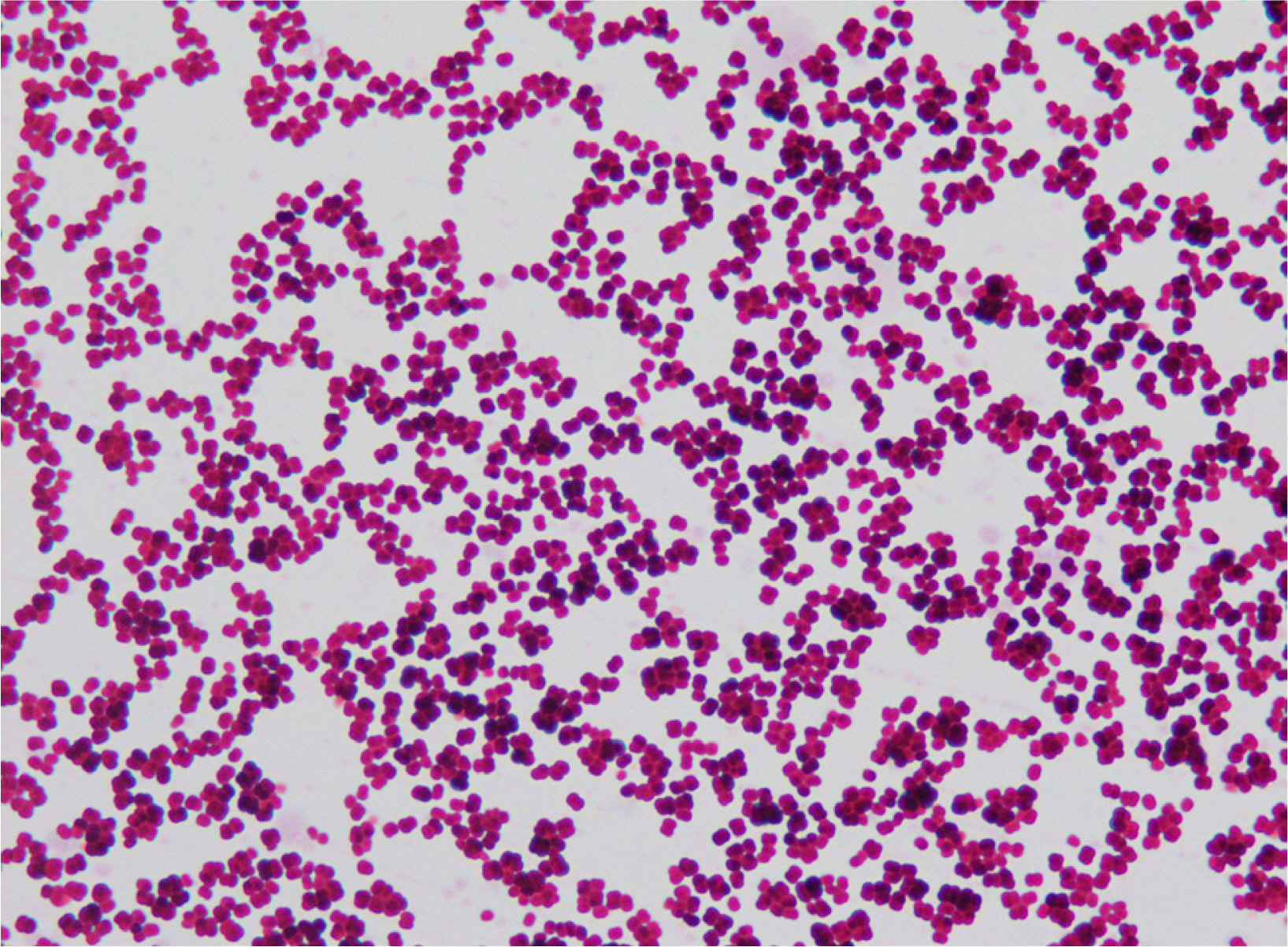Lab Med Online.
2021 Jan;11(1):69-72. 10.47429/lmo.2021.11.1.69.
A Case of Infective Endocarditis Caused by Kytococcus schroeteri
- Affiliations
-
- 1Department of Laboratory Medicine , Seoul National University College of Medicine, Seoul, Korea
- 2Department of Laboratory Medicine, Seoul National University Hospital, Seoul, Korea
- 3Department of Laboratory Medicine, Seoul National University Boramae Medical Center, Seoul, Korea
- KMID: 2525784
- DOI: http://doi.org/10.47429/lmo.2021.11.1.69
Abstract
- Kytococcus spp. is a skin bacterial flora that rarely causes human infections.K. schroeteri has been reported to cause infective endocarditis and bloodstream infections in patients with prosthetic valves and leukemia, respectively. In this study, we report a case of infective endocarditis caused by K. schroeteri. A 46-year-old man who underwent valve replacement surgery for aortic dissection 5 months ago was admitted. The patient had intermittent fever, suggestive of infective endocarditis. Gram-positive bacteria were detected in one aerobic blood culture bottle among 3 pairs of blood cultures and identified as Dermacoccus nishinomiyaensis/K. sedentarius by the VITEK ® 2 system (bioMérieux, USA). However, K. schroeteri was identified by the microflex™ LT biotyper (Bruker Daltonics, Germany; score 2.037), and the sequence of the 16S rRNA showed 99.79% similarity with that of K. schroeteri. The patient received antibiotics, including gentamicin, vancomycin, and rifampin. Four sequential follow-up peripheral blood cultures were negative for microorganisms, and the patient recovered from infective endocarditis. To our knowledge, this is the first reported case of infective endocarditis caused by K. schroeteri in Korea.
Keyword
Figure
Reference
-
1. Becker K, Schumann P, Wüllenweber J, Schulte M, Weil HP, Stackebrandt E, et al. 2002; Kytococcus schroeteri sp. nov., a novel Gram-positive actinobacterium isolated from a human clinical source. Int J Syst Evol Microbiol. 52:1609–14. DOI: 10.1099/00207713-52-5-1609. PMID: 12361263.2. Le Brun C, Bouet J, Gautier P, Avril J-L, Gaillot O. 2005; Kytococcus schroeteri endocarditis. Emerg Infect Dis. 11:179–80. DOI: 10.3201/eid1101.040761. PMID: 15714667. PMCID: PMC3294353.3. Mnif B, Boujelbène I, Mahjoubi F, Gdoura R, Trabelsi I, Moalla S, et al. 2006; Endocarditis due to Kytococcus schroeteri: case report and review of the literature. J Clin Microbiol. 44:1187–9. DOI: 10.1128/JCM.44.3.1187-1189.2006. PMID: 16517928. PMCID: PMC1393139.4. Renvoise A, Roux V, Casalta JP, Thuny F, Riberi A. 2008; Kytococcus schroeteri, a rare agent of endocarditis. Int J Infect Dis. 12:223–7. DOI: 10.1016/j.ijid.2007.06.011. PMID: 17919958.5. Yousri T, Hawari M, Saad R, Langley S. 2010; Kytococcus schroeteri prosthetic valve endocarditis. BMJ Case Rep. 2010:bcr0620103064. DOI: 10.1136/bcr.06.2010.3064. PMID: 22778375. PMCID: PMC3028120.6. Tamtami WNAI, Yaquobi FAI, Jardani AAI, Riyami MAI, Cormican M. 2019; First report of Kytococcus schroeteri prosthetic valve endocarditis in Oman. J Microbiol Exp. 7:247–8.7. Blennow O, Westling K, Fröding I, Ozenci V. 2012; Pneumonia and bacteremia due to Kytococcus schroeteri. J Clin Microbiol. 50:522–4. DOI: 10.1128/JCM.01245-11. PMID: 22162554. PMCID: PMC3264184.8. Amaraneni A, Malik D, Jasra S, Chandana SR, Garg D. 2015; Kytococcus schroeteri bacteremia in a patient with hairy cell leukemia: a case report and review of the literature. Case Rep Infect Dis. 2015:217307. DOI: 10.1155/2015/217307. PMID: 26064718. PMCID: PMC4439477.9. Ha J, Kim KH, Kim JO, Hong JS, Jeong SH, Lee K. 2015; Bacteraemia caused by Kytococcus schroeteri in a pneumonia patient. J Med Microbiol Diagn. 4:1000199. DOI: 10.4172/2161-0703.1000199.10. Clinical and Laboratory Standards Institute. 2015. Methods for antimicrobial dilution and disk susceptibility testing of infrequently isolated or fastidious bacteria. 3rd ed. Clinical and Laboratory Standards Institute;Wayne, PA:11. Clinical and Laboratory Standards Institute. 2019. Performance standards for antimicrobial susceptibility testing. CLSI supplement M100. 29th ed. Clinical and Laboratory Standards Institute;Wayne, PA:12. Stackebrandt E, Koch C, Gvozdiak O, Schumann P. 1995; Taxonomic dissection of the genus Micrococcus: Kocuria gen. nov., Nesterenkonia gen. nov., Kytococcus gen. nov., Dermacoccus gen. nov., and Micrococcus Cohn 1872 gen. emend. Int J Syst Bacteriol. 45:682–92. DOI: 10.1099/00207713-45-4-682. PMID: 7547287.13. Kämpfer P, Martin K, Schäfer J, Schumann P. 2009; Kytococcus aerolatus sp. nov., isolated from indoor air in a room colonized with moulds. Syst Appl Microbiol. 32:301–5. DOI: 10.1016/j.syapm.2009.05.004. PMID: 19541443.14. Shah AS, Vijayvargiya P, Jung S, Wilson JW. 2019; Postoperative hardware-related infection from Kytococcus schroeteri: its association with prosthetic material and hematological malignancies-A report of a case and review of existing literature. Case Rep Infect Dis. 2019:6936472. DOI: 10.1155/2019/6936472. PMID: 31019817. PMCID: PMC6451804.15. Li JS, Sexton DJ, Mick N, Nettles R, Fowler VG Jr, Ryan T, et al. 2000; Proposed modiÿcations to the Duke criteria for the diagnosis of infective endocarditis. Clin Infect Dis. 30:633–8. DOI: 10.1086/313753. PMID: 10770721.16. Habib G, Lancellotti P, Antunes MJ, Bongiorni MG, Casalta JP, Del Zotti F, et al. 2015; 2015 ESC Guidelines for the management of infective endocarditis: The task force for the management of infective endocarditis of the European Society of Cardiology (ESC). Endorsed by: European Association for Cardio-Thoracic Surgery (EACTS), the European Association of Nuclear Medicine (EANM). Eur Heart J. 36:3075–128. DOI: 10.1093/eurheartj/ehv319. PMID: 26320109.17. Clark AE, Kaleta EJ, Arora A, Wolk DM. 2013; Matrix-assisted laser desorption ionization-time of flight mass spectrometry: a fundamental shift in the routine practice of clinical microbiology. Clin Microbiol Rev. 26:547–603. DOI: 10.1128/CMR.00072-12. PMID: 23824373. PMCID: PMC3719498.18. Clinical and Laboratory Standards Institute. 2018. Interpretive criteria for identification of bacteria and fungi by targeted DNA sequencing. CLSI guideline MM18. 2nd ed. Clinical and Laboratory Standards Institute;Wayne, PA:19. Vincent LL, Otto CM. 2018; Infective endocarditis: update on epidemiology, outcomes, and management. Curr Cardiol Rep. 20:86. DOI: 10.1007/s11886-018-1043-2. PMID: 30117004.20. Slipczuk L, Codolosa JN, Davila CD, Romero-Corral A, Yun J, Pressman GS, et al. 2013; Infective endocarditis epidemiology over five decades: a systematic review. PLoS One. 8:e82665. DOI: 10.1371/journal.pone.0082665. PMID: 24349331. PMCID: PMC3857279.
- Full Text Links
- Actions
-
Cited
- CITED
-
- Close
- Share
- Similar articles
-
- A Case of Infective Endocarditis caused by Abiotrophia defectiva in Korea
- A case of Libman-Sacks endocarditis confused with infective endocarditis
- Pyogenic Arthritis of the Shoulder in Patient with Infective Endocarditis: A Case Report
- Delayed Rupture of Sinus of Valsalva after Infective Endocarditis: A Case Report
- A case of Haemophilus aphrophilus native valve endocarditis


